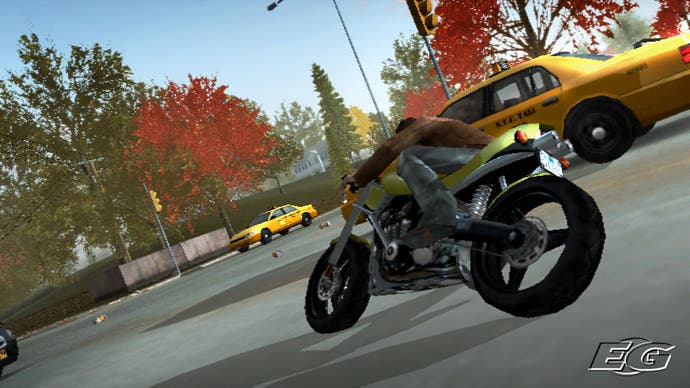Driver Parallel Lines
Union City Blues.
It has taken three long years to get over the abject misery of playing the last Driver game. Lest we forget, it was a title with so much expected of its four years of development. Yet Reflections' massively hyped game emerged in such a sorry bug-ridden and unplayable state that it should serve as the textbook example of When Game Development Goes Wrong. That the follow-up, Parallel Lines, should end up being slightly above par felt like a triumph, if you can believe that.
But, but, but. This is old news. As you know, Parallel Lines is an 18 month old PS2 and Xbox game - and one that has long since - deservedly - been relegated to the bargain bins by a largely apathetic public. Why bother, at this late stage, shovelling it lovelessly onto the Wii? Rather like the belated release of Scarface last month, it's presumably an exercise in mopping up the stragglers who fancy some GTA-style openworld driving n' shootin' shenanigans on the Wii in the absence of the real thing. Fair enough, then.
Heart of Glass
Judged on its own merits, it's not a bad game at all - but pretty far away from being a great one, either. It's a solid, albeit charmless affair, which plays things straight - both in terms of the too-cool-for-school storyline, and the way the game plays to the strengths of the Driver series by, gosh, focusing mainly on driving. Well, after the absolutely disastrous on-foot sections in the previous game, that's no great shock.

As with the original, it has 32 main story missions, 18 of which are set in 1978, and the remainder in 2006. You play TK: a budding, laid back 18 year-old "country boy made good" wheelman. For reasons best known to this floppy haired dude, he unquestioningly takes on one hare-brained assignment after another to prove he has what it takes to do the pointless dirty work of all the low-down New York criminals he comes across. What an incentive.
Eager to earn money, you start out doing fairly typical lightweight tasks, such as proving you can drive really fast, or picking up packages and bringing them back to base - the kind of tutorial-style missions that every Grand Theft Also likes to include to get people up to speed. Necessary, but also pretty mind numbing if you, like us, have played every last one of these games down the years.
Hanging on the Telephone
Most interesting about this version, of course, is the way the controls have been modified to take advantage of the Wii remote and Nunchuk. As with Scarface, it works very intuitively, with the Nunchuk used for steering/movement, handbrake turns, acceleration and brake, while the remote primarily acts as the means for aiming, camera control and firing. One of the only bright spots about Driv3r was the vehicle handling, car physics and car modelling, and there's an assured solidity that makes the game feel fun when you're hurtling around the streets. In true Reflections style, it's pretty much designed so you're always smashing into god knows what, sending litter and debris flying as you squeeze your way down narrow alleyways on the run from the law.

With the C button assigned to accelerate, Z for brake, and the analogue stick for steering, it's an initially unnatural configuration, but one which quickly becomes second nature. Once you're schooled in the art of handbrake turns, it slots together very nicely indeed. By simply turning the Nunchuk sideways (or, pulled towards you) in the appropriate direction of the turn, you can screech your way around corners with subtle, feathery (thanks Tom) precision. You won't be complaining about the core driving side of the game at all, which occupies a solid middle ground between GTA's exaggerated slide-a-thon and the more studied real-world simulation style preferred in games like TOCA Race Driver. It's a game which can implement racing missions and not make them feel like tacked-on extras - like so many other city-based openworld titles.
Better still, the ability to press the A button and shoot from within your car feels intuitively implemented, with the kind of effortless aiming precision that simply wasn't possible before the Wii remote arrived on the scene. Finally, you can loose off rounds with the B button with aplomb while still having total control of the driving side of the game. With that solid framework in place, Driver Parallel Lines ought to have been an excellent prospect on Wii. So why isn't it?


